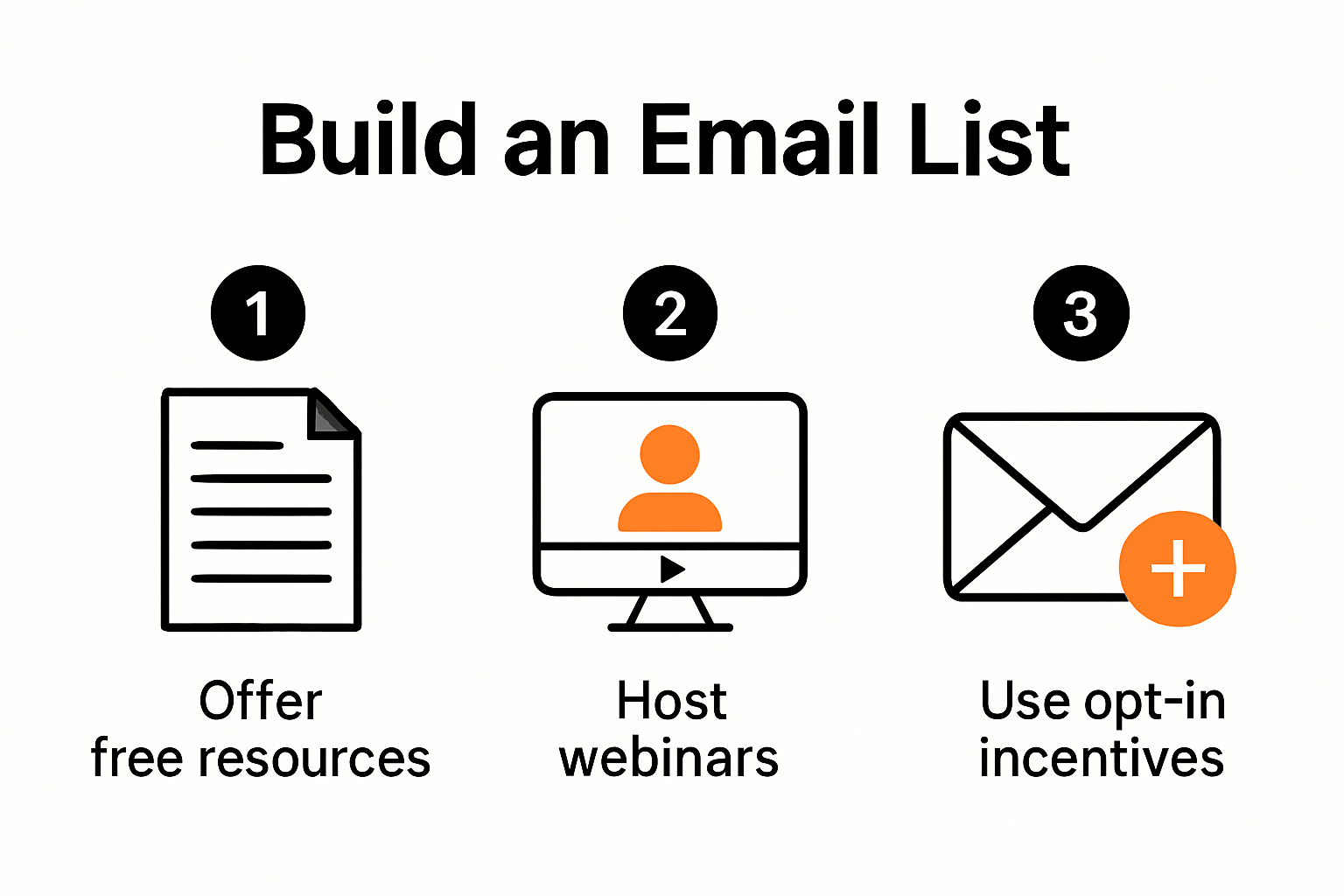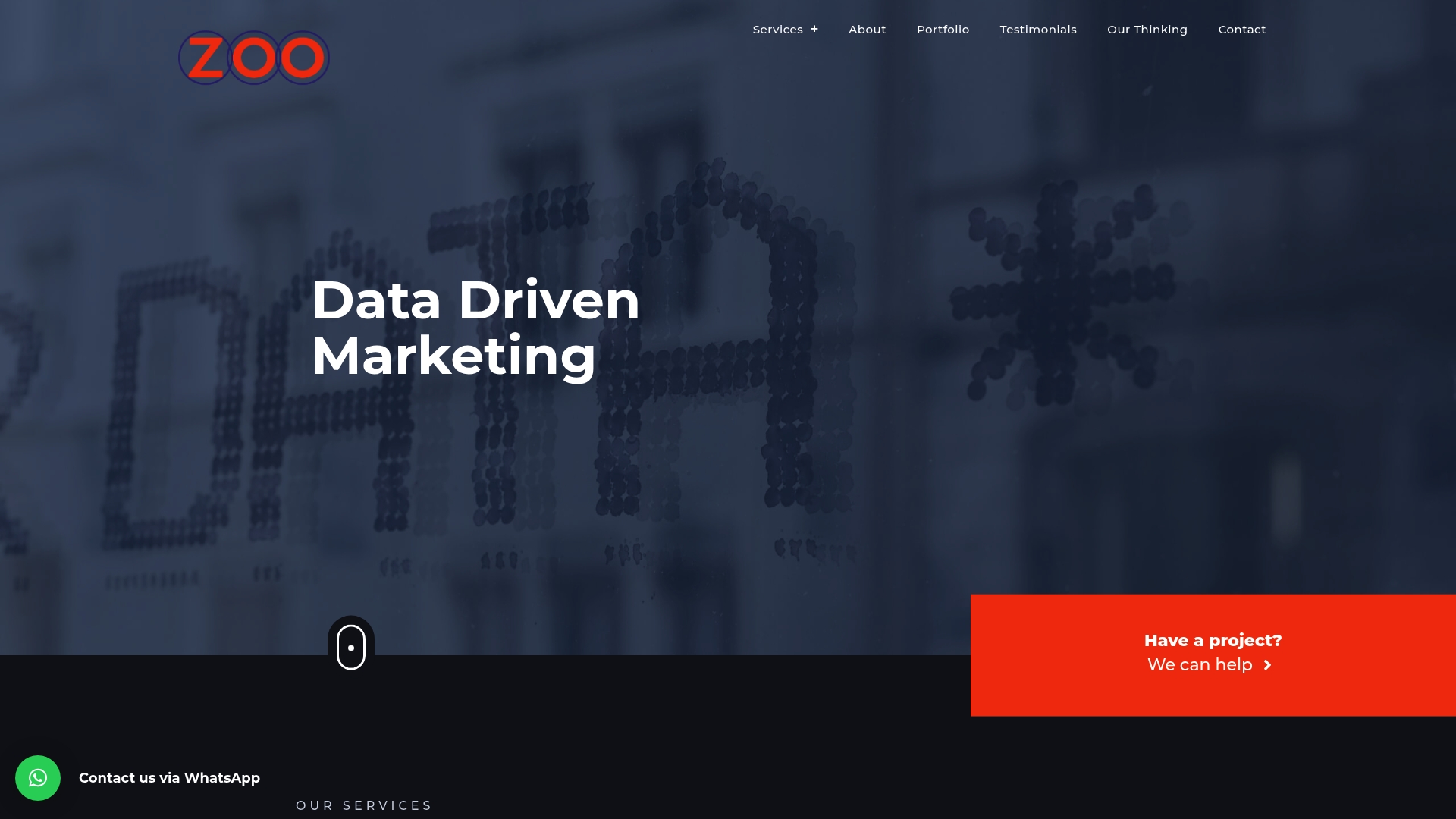Email marketing is still leading the way for small business owners looking to grow their brand and connect with their customers. Now for the surprise. While some reckon it is old-fashioned and getting ignored, the reality is a bit different. Personalised emails can increase click rates by a massive 139% and over 64% of email opens now happen on mobile devices. The real trick is knowing how to craft the right message for the right person at the right time. This approach is turning what many see as an outdated tactic into the most effective tool for real engagement in 2025.
Table of Contents
- Building A Targeted Email List Effectively
- Crafting Engaging And Mobile-Friendly Emails
- Personalising Email Campaigns For Better Results
- Analysing Performance And Optimising Strategies
Quick Summary
| Takeaway | Explanation |
|---|---|
| Build an engaged email list organically | Focus on valuable content offerings to attract subscribers genuinely interested in your business. |
| Segment your email list for relevance | Divide your list into targeted groups based on interests or behaviors for more effective communication. |
| Optimize emails for mobile devices | Ensure emails are visually appealing and functional on mobile platforms, as most opens occur on smartphones. |
| Implement advanced personalization techniques | Use customer data to tailor content, making emails feel relevant and personalized to each subscriber. |
| Track essential metrics to gauge success | Monitor open rates, click-through rates, and conversion rates to refine and improve your email strategies continuously. |
Building a Targeted Email List Effectively
Creating a targeted email list is the foundation of successful email marketing for small businesses. Unlike traditional mass marketing approaches, modern email strategies focus on quality over quantity. The goal is to build an engaged audience genuinely interested in your offerings.
Organic List Building Strategies
Building an email list organically requires strategic thinking and valuable content offerings. According to a study on email marketing optimization, research shows that targeted approaches can increase conversions by up to 50% while reducing unnecessary email communications.
Small businesses should prioritize permission-based list building techniques. This means creating compelling reasons for potential subscribers to willingly share their email addresses. Some effective methods include:
- Free Resources: Develop downloadable guides, e-books, or checklists that provide genuine value to your target audience.
- Webinar Invitations: Host online events that address specific challenges your potential customers face.
- Newsletter Sign-up Incentives: Offer exclusive content or first-access discounts for email subscribers.
The key is to make your email sign-up process transparent and attractive. Potential subscribers want to know exactly what they’ll receive and how it benefits them. Be clear about the frequency of emails and the type of content they can expect.

Segmentation and Personalization
Email list effectiveness goes beyond initial collection. Higher education marketing experts emphasize the critical importance of list segmentation. By dividing your email list into specific groups based on interests, behaviors, or demographics, you can create more targeted and relevant communications.
Consider implementing segmentation strategies such as:
- Grouping subscribers by purchase history
- Categorizing based on engagement levels
- Separating by specific interests or product preferences
Personalization is no longer optional. Modern subscribers expect emails that speak directly to their needs and interests. This means moving beyond generic “Dear Subscriber” messages to creating content that feels individually crafted.
One crucial warning for small businesses: never purchase email lists. These lists are typically low-quality, can damage your sender reputation, and often violate email marketing regulations. Instead, learn more about strategic marketing approaches that build genuine connections with potential customers.
Technical considerations are equally important. Ensure your email collection forms are simple, mobile-friendly, and comply with data protection regulations. Use double opt-in processes to confirm subscriber intent and maintain a clean, engaged email list.
Remember that building a targeted email list is an ongoing process. Regularly clean your list by removing inactive subscribers, monitor engagement metrics, and continuously refine your approach. A smaller, more engaged list will always outperform a large, disinterested collection of email addresses.
The most successful email marketing strategies treat each subscriber as a valued individual, not just another contact in a database. By focusing on quality, relevance, and genuine value, small businesses can create email lists that drive real business growth.
Here is a table summarising common organic list-building strategies and their subscriber appeal:
| Strategy | Description | Subscriber Appeal |
|---|---|---|
| Free Resources | E-books, guides, or checklists for download | High—offers clear, useful value |
| Webinar Invitations | Access to online events solving real challenges | Moderate to High—interactive & engaging |
| Newsletter Sign-up Incentives | Exclusive content or early discounts for subscribers | High—provides immediate, tangible benefit |
| Simple Sign-up Forms | Easy, mobile-friendly, transparent information collection | Moderate—removes barriers to entry |
| Double Opt-in Process | Confirms genuine interest and subscriber intent | High—builds trust and quality list |
Crafting Engaging and Mobile-Friendly Emails

Email design has evolved dramatically, with mobile devices now dominating digital communication. Research indicates that 64% of email opens occur on smartphones and tablets, making mobile optimization critical for small businesses seeking effective email marketing strategies.
Design and Visual Optimization
Creating mobile-friendly emails requires a strategic approach to design. According to Campaign Monitor, successful mobile email design involves several key principles. Use single-column layouts that adapt seamlessly across different screen sizes. Font sizes should be generous, with a minimum of 14 pixels for body text to ensure readability on smaller screens.
Visual elements must be carefully considered. Large, tappable buttons at least 44 pixels wide improve user interaction. Images should be compressed and optimized to load quickly, preventing potential subscriber frustration. Use responsive design techniques that automatically adjust content layout based on the device screen.
Compelling Content and Subject Lines
Subject lines are your first and most critical engagement point. Zendesk research reveals that mobile email clients typically display only 33 to 43 characters of a subject line. This limited space demands precision and creativity.
Effective subject lines should:
- Create Urgency: Use time-sensitive language
- Personalize: Include recipient’s name or specific interests
- Provide Clear Value: Communicate immediate benefit
Content within the email must be concise and scannable. Break text into short paragraphs, use subheadings, and employ bullet points to enhance readability. Remember that mobile users often skim content quickly, so make your key messages stand out.
Technical Considerations and User Experience
Technical optimization goes beyond visual design. Ensure your email templates are coded using responsive HTML that automatically adjusts to different screen sizes. Test your emails across multiple devices and email clients to guarantee consistent performance.
Consider the technical limitations of mobile devices. Large file sizes can slow down loading times, potentially causing users to abandon your email. Optimize image sizes, minimize complex graphics, and prioritize fast-loading content.
A critical aspect often overlooked is touch-friendly design. Small businesses must design emails with finger-tapping in mind. This means:
- Spacing links and buttons generously
- Avoiding content clustering
- Using clear, high-contrast color schemes
By focusing on strategic marketing approaches, small businesses can transform their email marketing. Mobile-friendly emails are no longer optional they are essential for engaging modern consumers.
Remember that great mobile email design is about creating a seamless, enjoyable user experience. Every element should serve a purpose, guiding the reader towards your desired action with clarity and simplicity.
Here’s a table comparing key mobile-friendly email design best practices and their impact on user experience:
| Best Practice | Description | Impact on User Experience |
|---|---|---|
| Single-column Layout | Adapts smoothly to all screen sizes | Improves readability on mobiles |
| Large Fonts (min 14px) | Ensures all text is legible on small screens | Reduces eye strain, easier reading |
| Big Tappable Buttons (44px+) | Allows for easier interaction on touch screens | Reduces input errors, boosts clicks |
| Optimized Images | Quick loading and scales for mobile | Prevents slow load times |
| Responsive Design | Automatically adjusts layout for device | Ensures consistency across devices |
| Clear, Short Subject Lines | 33–43 character limit for top engagement | Prevents truncation in inbox |
Personalising Email Campaigns for Better Results
Personalization has transformed email marketing from generic mass communications to targeted, meaningful interactions. Research from Adobe Experience Cloud reveals that personalized emails can increase click rates by an impressive 139%, demonstrating the powerful impact of tailored content.
Understanding Personalization Strategies
Effective email personalization goes far beyond simply inserting a recipient’s name. The American Marketing Association outlines comprehensive strategies that small businesses can implement to create more engaging email experiences.
Key personalization techniques include:
- Behavioral Tracking: Use customer interaction data to customize content
- Segmentation: Divide your audience into specific groups with unique interests
- Dynamic Content: Adjust email elements based on individual user preferences
For instance, an online clothing retailer could send different product recommendations to customers based on their previous purchase history or browsing behavior. This approach makes each email feel like a personalized recommendation rather than a generic promotional message.
Data-Driven Personalization Approaches
William & Mary University research highlights that 82% of marketers have observed higher open rates with personalized emails. This statistic underscores the importance of moving beyond basic personalization tactics.
Small businesses can leverage personalization by:
- Collecting and analyzing customer data responsibly
- Creating detailed customer personas
- Developing targeted content that speaks directly to specific audience segments
Technical implementation matters. Ensure your email marketing platform supports advanced personalization features like dynamic content insertion, behavioral triggered emails, and sophisticated segmentation capabilities.
Subject lines represent a critical personalization touchpoint. Explore our insights on digital marketing strategies to understand how subtle personalization can dramatically improve engagement rates.
Privacy considerations are paramount. Always be transparent about data collection and provide clear opt-out mechanisms. Customers appreciate personalization but are equally concerned about their data privacy.
Remember that personalization is an ongoing process. Continuously test different approaches, monitor engagement metrics, and refine your strategies. What works today might need adjustment tomorrow as customer preferences evolve.
The most successful email campaigns treat each subscriber as a unique individual with specific needs and interests. By investing time and resources in sophisticated personalization techniques, small businesses can create email experiences that truly resonate with their audience.
Analysing Performance and Optimising Strategies
Email marketing success hinges on continuous performance analysis and strategic optimization. Penn State Extension emphasizes the critical importance of tracking key metrics to understand and improve email campaign effectiveness.
Essential Email Marketing Metrics
Small businesses must focus on several core performance indicators to gauge their email marketing success. These metrics provide insights into campaign performance and areas requiring improvement:
- Open Rates: Measure how many subscribers actually open your emails
- Click-Through Rates: Track the percentage of readers who click on links within your email
- Conversion Rates: Evaluate how many email recipients take the desired action
- Unsubscribe Rates: Monitor how many people opt out of your email list
- Bounce Rates: Assess the number of emails that fail to deliver
Research from advanced recommendation systems demonstrates that strategic analysis can lead to significant improvements, with some studies showing up to 50% increase in conversions by optimizing email approaches.
Continuous Improvement Strategies
Optimization is an ongoing process. Small businesses should implement a systematic approach to email marketing analysis. This involves:
- Regular performance reviews
- A/B testing of different email elements
- Segmentation refinement
- Content relevance assessment
Technical tools play a crucial role in this process. Modern email marketing platforms offer sophisticated analytics that go beyond basic metrics. Discover more about marketing analytics techniques to unlock deeper insights into your email performance.
Interpreting metrics requires a nuanced approach. Low open rates might indicate problems with subject lines or sending times. Poor click-through rates could suggest irrelevant content or ineffective call-to-action design. Each metric tells a story about your email marketing effectiveness.
Advanced Optimization Techniques
Beyond basic metric tracking, advanced optimization involves:
- Predictive analytics to forecast email performance
- Machine learning algorithms for content personalization
- Detailed subscriber behavior analysis
- Automated optimization recommendations
Privacy and data protection remain paramount. Always ensure your analytics practices comply with relevant regulations. Collect and analyze data responsibly, maintaining transparency with your subscribers.
The most successful email marketing strategies treat analytics as a continuous improvement cycle. What works today might not work tomorrow. Regular testing, learning, and adapting are key to long-term success.
Remember that numbers tell a story. Behind every metric is a real person interacting with your content. Use these insights to create more meaningful, engaging email experiences that truly resonate with your audience.
Frequently Asked Questions
What are the best strategies for building an email list organically?
To build an email list organically, focus on providing value through free resources like e-books and checklists, hosting webinars, and offering exclusive content or discounts for newsletter sign-ups. Ensure your sign-up forms are simple, and be transparent about what subscribers can expect.
How can I create mobile-friendly emails for my small business?
To create mobile-friendly emails, use single-column layouts, ensure font sizes are at least 14 pixels for readability, include large tappable buttons, and optimize images for fast loading. Test your emails across multiple devices to ensure they display correctly.
What are effective personalization strategies for email marketing?
Effective personalization strategies include using behavioral tracking to customize content, segmenting your audience based on interests, and implementing dynamic content that adapts to individual preferences. Personalised emails significantly increase engagement rates.
How can I analyse the performance of my email marketing campaigns?
To analyse your email marketing campaigns, focus on key metrics such as open rates, click-through rates, conversion rates, and unsubscribe rates. Use A/B testing to refine your email elements and regularly review performance for continuous improvement.
Transform Email Marketing Into Real Growth for Your Small Business
Stuck with low engagement or tired of email campaigns that go unnoticed? Many small businesses struggle to build a high-quality list, personalise their message, and measure what truly works. This guide highlights that real results depend on targeted segmentation, advanced analytics, and mobile-ready communication. If your emails are not driving more sales or growing real relationships, it’s time to rethink your strategy.

Take the next step with our team at Zoo Digital. We specialise in data-driven marketing strategies that turn best practices into measurable profit. From CRM setup and list segmentation to powerful automation, our experts help you deliver personalised emails that your customers want to read. Discover more about impactful solutions on our Digital Strategy page. If you are ready to see what is possible with proper tools and insight, act now so your communications are never ignored again.
Recommended
- Digital Marketing for Beginners: 2025 Guide for Small Businesses – Zoo Digital
- How to Build a Marketing Strategy for Small Businesses in 2025 – Zoo Digital
- Digital Marketing Terms Explained for Small Businesses 2025 – Zoo Digital
- Digital Marketing Budget Allocation: Smart Planning for 2025 – Zoo Digital

